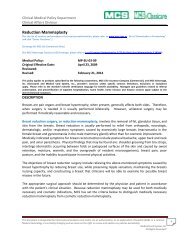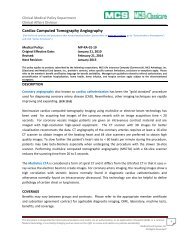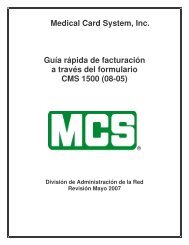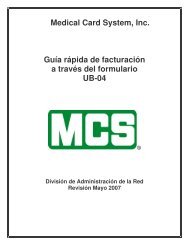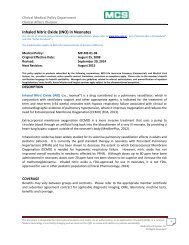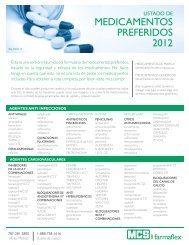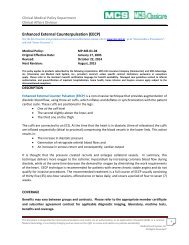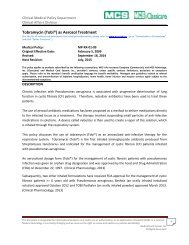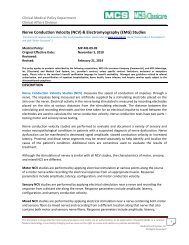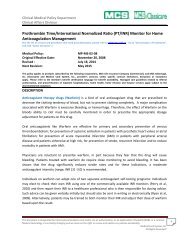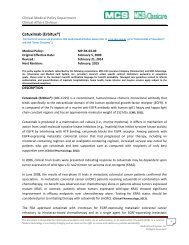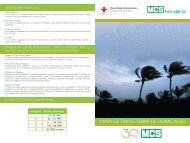Blepharoplasty - MCS a
Blepharoplasty - MCS a
Blepharoplasty - MCS a
You also want an ePaper? Increase the reach of your titles
YUMPU automatically turns print PDFs into web optimized ePapers that Google loves.
Clinical Medical Policy Department<br />
Clinical Affairs Division<br />
<strong>Blepharoplasty</strong><br />
[For the list of services and procedures that need preauthorization, please refer to www.mcs.com.pr. Go to“Comunicados a Proveedores”,<br />
and click “Cartas Circulares”.]<br />
Medical Policy:<br />
MP-SU-05-11<br />
Original Effective Date: October 27, 2011<br />
Reviewed:<br />
Revised: February 21, 2014<br />
This policy applies to products subscribed by the following corporations, <strong>MCS</strong> Life Insurance Company (Commercial), and <strong>MCS</strong> Advantage,<br />
Inc. (Classicare) and Medical Card System, Inc., provider’s contract; unless specific contract limitations, exclusions or exceptions<br />
apply. Please refer to the member’s benefit certification language for benefit availability. Managed care guidelines related to referral<br />
authorization, and precertification of inpatient hospitalization, home health, home infusion and hospice services apply subject to the<br />
aforementioned exceptions.<br />
DESCRIPTION<br />
<strong>Blepharoplasty</strong> is the medical term given to an eyelid surgical procedure that removes excess folds of<br />
skin in the upper lids and pouches under the eyes or the lower lids (Ehealth MD, 2013).<br />
Reconstructive blepharoplasty i corrects a visual impairment caused by drooping redundant skin or<br />
muscle laxity. In the absence of any documented functional limitations to the patient’s vision, the<br />
procedure is considered cosmetic surgery ii . <strong>Blepharoplasty</strong> is also considered cosmetic when performed<br />
to correct eyelid position in a patient with an ocular prosthesis (Interqual® 2013).<br />
Upper eyelid blepharoplasty is performed if the excess droopy upper eyelid skin (dermatochalasis) is<br />
causing problems from overhang, impairing vision, sitting on the upper eyelashes or causing headache<br />
and tiredness from continually lifting the eyebrows and forehead in order to lift the skin off the lashes.<br />
Excess droopy upper eyelid skin can also be associated with eyelid ptosis (drooping upper eyelid) or<br />
eyebrow ptosis (drooping of the eyebrows), therefore a careful facial examination is required, as this<br />
may also have to be addressed surgically (Oculoplastics.co.uk, Inc.; n.d.).<br />
Lower eyelid blepharoplasty is performed if the lower eyelids are excessively puffy. Lower eyelid<br />
surgery is very delicate and therefore precise ophthalmic assessment is needed to determine the<br />
amount of protrusion from fat or from loose skin, the degree of eyelid laxity and whether there are dry<br />
eyes. Several different aspects may have to be addressed. Some patients have a medical cause for<br />
puffy lower eyelids such as Graves' ophthalmopathy (also known as thyroid eye disease) — these<br />
patients typically have excess fatty protrusion or bags. However, lower lid blepharoplasty is most<br />
commonly performed for cosmetic or aesthetic reasons (Oculoplastics.co.uk, Inc.; n.d.).<br />
<strong>Blepharoplasty</strong> is often done in combination with other procedures such as a brow-lift or facelift. This<br />
may be done to restore more complete function or facial expression as well as for aesthetic reasons.<br />
Advances in technique, including laser applications, have lead to greater patient comfort, fewer<br />
complications and more rapid recovery (ASPS, 2007).<br />
This document is designated for informational purposes only and is not an authorization, or an explanation of benefits (EOB), or a contract.<br />
Medical technology is constantly changing and we reserves the right to review and update our policies periodically.<br />
Medical Card System, Inc.<br />
All Rights Reserved®<br />
1
Clinical Medical Policy Department<br />
Clinical Affairs Division<br />
Dermatochalasis is a common finding seen in elderly persons and occasionally in young adults, in which<br />
redundant and lax eyelid skin and muscle is found. Gravity, loss of elastic tissue in the skin, and<br />
weakening of the connective tissues of the eyelid frequently contribute to this lax and redundant eyelid<br />
tissue. These findings are more common in the upper eyelids but can be seen in the lower eyelids as<br />
well. Some systemic diseases also may predispose patients to develop dermatochalasis. These include<br />
thyroid eye disease, renal failure, trauma, cutis laxa, Ehlers-Danlos syndrome, amyloidosis, hereditary<br />
angioneurotic edema, and xanthelasma. Genetic factors may play a role in some patients (Gilliland,<br />
2012).<br />
Blepharochalasis syndrome is separate and distinct from dermatochalasis and is a rare disorder that<br />
typically affects the upper eyelids. Blepharochalasis syndrome is characterized by intermittent eyelid<br />
edema, which frequently recurs. This results in relaxation of the eyelid tissue and resultant atrophy. In<br />
approximately 50% of patients, it is unilateral (Gilliland, 2012).<br />
Blepharoptosis, also known as Ptosis, refers to the drooping of the upper eyelid below its normal<br />
position secondary to muscle weakness or nerve dysfunction. The normal position of the upper eyelid is<br />
> 2.5 mm above the mid-pupil. The drooping of the upper eyelid can be assessed by comparing the<br />
current appearance to previous photographs (Interqual® 2013). There are four types of acquired Ptosis:<br />
a. Aponeurogenic or Involutional- the most common type, caused by age-related degeneration of<br />
the levator muscle and its tendon;<br />
b. Myogenic- muscular weakness secondary to genetic or immunological disorders such as<br />
Myasthenia Gravis;<br />
c. Neurogenic- Third Cranial Nerve control of the eyelid muscles is disrupted secondary to<br />
inflammation, infection, or demyelination as seen in Horner’s Syndrome;<br />
d. Mechanical- Tumors or post inflammatory scarring can disrupt the levator muscle function<br />
(Interqual® 2013).<br />
COVERAGE<br />
Benefits may vary between groups and contracts. Please refer to the appropriate member certificate<br />
and subscriber agreement contract for applicable diagnostic imaging, DME, laboratory, machine tests,<br />
benefits and coverage.<br />
INDICATIONS<br />
Medical Card System, Inc., (<strong>MCS</strong>) may consider the following procedures medically necessary when the<br />
criteria described below are met:<br />
This document is designated for informational purposes only and is not an authorization, or an explanation of benefits (EOB), or a contract.<br />
Medical technology is constantly changing and we reserves the right to review and update our policies periodically.<br />
Medical Card System, Inc.<br />
All Rights Reserved®<br />
2
Clinical Medical Policy Department<br />
Clinical Affairs Division<br />
A. <strong>Blepharoplasty</strong> procedure of the Upper Eyelid may be considered medically necessary for ANY of<br />
the following indications:<br />
1. When the goal of the surgery is to restore functional and normalcy to a structure that has<br />
been altered by trauma, infection, inflammation, degeneration, neoplasia, or developmental<br />
errors (CMS LCD L29485, 2009).<br />
2. Visual impairment with near or far vision due to dermatochalasis, blepharochalasis, or<br />
blepharoptosis, or brow ptosis (CMS LCD L29485, 2009).<br />
3. Visual impairment secondary to redundant skin weighting down on upper lashes (CMS LCD<br />
L29485, 2009).<br />
4. Chronic, symptomatic dermatitis of pretarsal skin caused by redundant upper lid skin which<br />
has not been successfully treated by normal first line measures such as education regarding<br />
hygiene, antibiotics, etc. (CMS LCD L29485, 2009).<br />
5. Prosthesis difficulties in an anophthalmia socket (CMS LCD L29485, 2009).<br />
6. When interference with vision or the visual field, difficulty reading due to upper eyelid<br />
drooping, looking through the eyelashes or seeing the upper eyelid skin as commonly seen<br />
with ptosis, pseudotosis or dermatochalasis (CMS LCD L29485, 2009).<br />
REQUISITES<br />
1. Visual Fields must be recorded using either a Goldman Perimeter (III 4-E test object) or<br />
a programmable automated perimeter (equivalent to a screening field with a single<br />
intensity strategy using a 10 dB stimulus) to test a superior (vertical) extent of 50-60<br />
degrees above fixation while using no wider than a 10 degree horizontal separation.<br />
Each eye should be tested with the upper eyelid at rest and repeated with the lid<br />
elevated to demonstrate an expected “surgical” improvement meeting or exceeding the<br />
criteria (CMS LCD L29485, 2009).<br />
2. The member must have a visual field interpretation that demonstrate a minimum 12<br />
degree or 30 percent loss of upper field of vision with upper skin and/or upper lid<br />
margin taped and untapped to demonstrate potential correction by the proposed<br />
procedure (CMS LCD L29485, 2009).<br />
3. High Quality & Color Photographs must be submitted and should be consistent with the<br />
degree of visual field impairment described in the medical records and demonstrated by<br />
the formal visual field testing, and the MRD measurements (Interqual®2013).<br />
a. Photographs – High Quality & Color prints or slides must be frontal, canthus to<br />
canthus with the head perpendicular to the plane of the camera (not tilted) to<br />
This document is designated for informational purposes only and is not an authorization, or an explanation of benefits (EOB), or a contract.<br />
Medical technology is constantly changing and we reserves the right to review and update our policies periodically.<br />
Medical Card System, Inc.<br />
All Rights Reserved®<br />
3
Clinical Medical Policy Department<br />
Clinical Affairs Division<br />
demonstrate a skin rash or position of the true lid margin or the pseudo-lid<br />
margin. If redundant skin coexists with true lid ptosis, additional photos must<br />
be taken with the upper lid skin retracted to show the actual position of the true<br />
lid margin (needed if both 15822-15823 is required and planned in addition to<br />
67901-67908) (CMS LCD L29485, 2009).<br />
b. Oblique photos are only needed to demonstrate redundant skin on the upper<br />
eyelashes when this is the only indication for surgery (CMS LCD L29485, 2009).<br />
4. Records must document that the upper eyelid margin approaches to within 2.5 mm<br />
(1/4 of the diameter of the visible iris) of the corneal light reflex (Marginal Reflex<br />
Distance (MRD)) (Interqual®2013).<br />
LIMITATIONS<br />
5. If both a blepharoplasty and a ptosis repair are planned, both must be individually<br />
documented. This may require one set of photographs and the visual fields, showing the<br />
effect of drooping of redundant skin (and its correction by taping), and the actual<br />
presence of blepharoptosis (CMS LCD L29485, 2009).<br />
6. Documentation must be provided if the patient has a condition which may prevent<br />
performance of the visual field testing such as: (CMS LCD L29485, 2009)<br />
a. Tremors<br />
b. Macular degeneration<br />
c. Physical deformities that prevent sitting up straight at the perimeter, and<br />
d. Glaucoma<br />
1. Medical Card System, Inc., (<strong>MCS</strong>) WILL NOT cover upper eyelid and brow surgical procedures<br />
performed for the sole purpose of improving appearances (CMS LCD L29485, 2009).<br />
2. Medical Card System, Inc., (<strong>MCS</strong>) WILL NOT cover lower eyelid blepharoplasty (CMS LCD L29398,<br />
2013).<br />
CODING INFORMATION<br />
CPT® Codes (List may not be all inclusive)<br />
CPT® Codes<br />
DESCRIPTION<br />
15822 <strong>Blepharoplasty</strong>, upper eyelid<br />
15823 <strong>Blepharoplasty</strong>, upper eyelid; with excessive skin weighting down lid<br />
This document is designated for informational purposes only and is not an authorization, or an explanation of benefits (EOB), or a contract.<br />
Medical technology is constantly changing and we reserves the right to review and update our policies periodically.<br />
Medical Card System, Inc.<br />
All Rights Reserved®<br />
4
Clinical Medical Policy Department<br />
Clinical Affairs Division<br />
67875 Temporary closure of eyelids by suture (eg, frost suture)<br />
67900 Repair of brow ptosis (supraciliary, mid-forehead or coronal approach)<br />
67901 Repair of blepharoptosis; frontalis muscle technique with suture or other material (eg,<br />
banked fascia)<br />
67902 Repair of blepharoptosis; frontalis muscle technique with autologous fascial sling<br />
(includes obtaining fascia)<br />
67903 Repair of blepharoptosis; (tarso) levator resection or advancement, internal approach<br />
67904 Repair of blepharoptosis; (tarso) levator resection or advancement, external approach<br />
67906 Repair of blepharoptosis; superior rectus technique with fascial sling (includes<br />
obtaining fascia)<br />
67908 Repair of blepharoptosis; conjunctivo-tarso-muller’s muscle-levator resection (eg,<br />
fasanella-servat type)<br />
67909 Reduction of overcorrection of ptosis<br />
67911 Correction of lid retraction<br />
67914 Repair of ectropion; suture<br />
67915 Repair of ectropion; thermocauterization<br />
67916 Repair of ectropion; excision tarsal wedge<br />
67917 Repair of ectropion; extensive (eg, tarsal strip operations)<br />
67921 Repair of entropion; suture<br />
67922 Repair of entropion; thermocauterization<br />
67923 Repair of entropion; excision tarsal wedge<br />
67924 Repair of entropion; extensive (eg, tarsal strip or capsulopalpbral fascia repairs<br />
operations)<br />
*Current Procedural Terminology (CPT®) 2013 American Medical Association: Chicago, IL.<br />
Non-Covered CPT® Codes (List may not be all inclusive)<br />
CPT® Codes<br />
DESCRIPTION<br />
15820 <strong>Blepharoplasty</strong>, lower eyelid<br />
15821 <strong>Blepharoplasty</strong>, lower eyelid, with extensive herniated fat pad<br />
*Current Procedural Terminology (CPT®) 2013 American Medical Association: Chicago, IL.<br />
ICD-9 CM® Diagnosis Codes (List may not be all inclusive)<br />
ICD-9-CM®<br />
DESCRIPTION<br />
CODES<br />
351.0 Bell’s palsy<br />
360.30 Unspecified hypotony of eye<br />
368.44 Other localized visual field defect<br />
370.34 Exposure keratoconjunctivitis<br />
374.00 Entropion, unspecified<br />
374.01 Senile entropion<br />
This document is designated for informational purposes only and is not an authorization, or an explanation of benefits (EOB), or a contract.<br />
Medical technology is constantly changing and we reserves the right to review and update our policies periodically.<br />
Medical Card System, Inc.<br />
All Rights Reserved®<br />
5
Clinical Medical Policy Department<br />
Clinical Affairs Division<br />
374.02 Mechanical entropion<br />
374.03 Spastic entropion<br />
374.04 Cicatricial entropion<br />
374.05 Trichiasis without entropion<br />
374.10 Ectropion, unspecified<br />
374.11 Senile ectropion<br />
374.12 Mechanical ectropion<br />
374.13 Spastic ectropion<br />
374.14 Cicatricial ectropion<br />
374.20 Unspecifice lagophthalmos<br />
374.21 Paralytic lagophthalmos<br />
374.22 Mechanical lagophthalmos<br />
374.23 Cicatricial lagophthalmos<br />
374.30 Unspecified ptosis of eyelid<br />
374.31 Paralytic ptosis<br />
374.32 Myogenic ptosis<br />
374.33 Mechanical ptosis<br />
374.34 Blepharochalasis<br />
374.41 Eyelid retraction or lag<br />
374.82 Edema of eyelid<br />
374.87 Dermatochalasis<br />
376.21 Thyrotoxic exophthalmos<br />
743.00 Clinical anophthalmos, unspecified<br />
743.61 Congenital ptosis<br />
743.62 Congenital deformity of eyelid<br />
743.63 Other specified congenital anomalies of eyelid<br />
996.69 Infection and inflammatory reaction due to other internal prosthetic device, implant,<br />
and graft<br />
V45.78 Acquired absence of organ, eye<br />
*2013 ICD-9-CM®For Physicians, VOLUMES I & II, Professional Edition (American Medical Association).<br />
ICD-10 Codes (Preview Draft)<br />
In preparation for changes in the coding systems form ICD- 9 to ICD -10, this policy includes a sample list<br />
of ICD-10 codes for your reference. These codes may become subject to changes or modifications since<br />
they will be in effect on October 1, 2014.<br />
ICD-10-Codes<br />
G51.0 Bell's palsy<br />
H44.40 Unspecified hypotony of eye<br />
DESCRIPTION<br />
H53.451 Other localized visual field defect, right eye<br />
H53.452 Other localized visual field defect, left eye<br />
H53.453 Other localized visual field defect, bilateral<br />
This document is designated for informational purposes only and is not an authorization, or an explanation of benefits (EOB), or a contract.<br />
Medical technology is constantly changing and we reserves the right to review and update our policies periodically.<br />
Medical Card System, Inc.<br />
All Rights Reserved®<br />
6
Clinical Medical Policy Department<br />
Clinical Affairs Division<br />
H53.459 Other localized visual field defect, unspecified eye<br />
H16.211 Exposure keratoconjunctivitis, right eye<br />
H16.212 Exposure keratoconjunctivitis, left eye<br />
H16.213 Exposure keratoconjunctivitis, bilateral<br />
H16.219 Exposure keratoconjunctivitis, unspecified eye<br />
H02.001 Unspecified entropion of right upper eyelid<br />
H02.002 Unspecified entropion of right lower eyelid<br />
H02.003 Unspecified entropion of right eye, unspecified eyelid<br />
H02.004 Unspecified entropion of left upper eyelid<br />
H02.005 Unspecified entropion of left lower eyelid<br />
H02.006 Unspecified entropion of left eye, unspecified eyelid<br />
H02.009 Unspecified entropion of unspecified eye, unspecified eyelid<br />
H02.031 Senile entropion of right upper eyelid<br />
H02.032 Senile entropion of right lower eyelid<br />
H02.033 Senile entropion of right eye, unspecified eyelid<br />
H02.034 Senile entropion of left upper eyelid<br />
H02.035 Senile entropion of left lower eyelid<br />
H02.036 Senile entropion of left eye, unspecified eyelid<br />
H02.039 Senile entropion of unspecified eye, unspecified eyelid<br />
H02.021 Mechanical entropion of right upper eyelid<br />
H02.022 Mechanical entropion of right lower eyelid<br />
H02.023 Mechanical entropion of right eye, unspecified eyelid<br />
H02.024 Mechanical entropion of left upper eyelid<br />
H02.025 Mechanical entropion of left lower eyelid<br />
H02.026 Mechanical entropion of left eye, unspecified eyelid<br />
H02.029 Mechanical entropion of unspecified eye, unspecified eyelid<br />
H02.041 Spastic entropion of right upper eyelid<br />
H02.042 Spastic entropion of right lower eyelid<br />
H02.043 Spastic entropion of right eye, unspecified eyelid<br />
H02.044 Spastic entropion of left upper eyelid<br />
H02.045 Spastic entropion of left lower eyelid<br />
H02.046 Spastic entropion of left eye, unspecified eyelid<br />
H02.049 Spastic entropion of unspecified eye, unspecified eyelid<br />
H02.011 Cicatricial entropion of right upper eyelid<br />
H02.012 Cicatricial entropion of right lower eyelid<br />
H02.013 Cicatricial entropion of right eye, unspecified eyelid<br />
H02.014 Cicatricial entropion of left upper eyelid<br />
This document is designated for informational purposes only and is not an authorization, or an explanation of benefits (EOB), or a contract.<br />
Medical technology is constantly changing and we reserves the right to review and update our policies periodically.<br />
Medical Card System, Inc.<br />
All Rights Reserved®<br />
7
Clinical Medical Policy Department<br />
Clinical Affairs Division<br />
H02.015 Cicatricial entropion of left lower eyelid<br />
H02.016 Cicatricial entropion of left eye, unspecified eyelid<br />
H02.019 Cicatricial entropion of unspecified eye, unspecified eyelid<br />
H02.051 Trichiasis without entropian right upper eyelid<br />
H02.052 Trichiasis without entropian right lower eyelid<br />
H02.053 Trichiasis without entropian right eye, unspecified eyelid<br />
H02.054 Trichiasis without entropian left upper eyelid<br />
H02.055 Trichiasis without entropian left lower eyelid<br />
H02.056 Trichiasis without entropian left eye, unspecified eyelid<br />
H02.059 Trichiasis without entropian unspecified eye, unspecified eyelid<br />
H02.101 Unspecified ectropion of right upper eyelid<br />
H02.102 Unspecified ectropion of right lower eyelid<br />
H02.103 Unspecified ectropion of right eye, unspecified eyelid<br />
H02.104 Unspecified ectropion of left upper eyelid<br />
H02.105 Unspecified ectropion of left lower eyelid<br />
H02.106 Unspecified ectropion of left eye, unspecified eyelid<br />
H02.109 Unspecified ectropion of unspecified eye, unspecified eyelid<br />
H02.131 Senile ectropion of right upper eyelid<br />
H02.132 Senile ectropion of right lower eyelid<br />
H02.133 Senile ectropion of right eye, unspecified eyelid<br />
H02.134 Senile ectropion of left upper eyelid<br />
H02.135 Senile ectropion of left lower eyelid<br />
H02.136 Senile ectropion of left eye, unspecified eyelid<br />
H02.139 Senile ectropion of unspecified eye, unspecified eyelid<br />
H02.121 Mechanical ectropion of right upper eyelid<br />
H02.122 Mechanical ectropion of right lower eyelid<br />
H02.123 Mechanical ectropion of right eye, unspecified eyelid<br />
H02.124 Mechanical ectropion of left upper eyelid<br />
H02.125 Mechanical ectropion of left lower eyelid<br />
H02.126 Mechanical ectropion of left eye, unspecified eyelid<br />
H02.129 Mechanical ectropion of unspecified eye, unspecified eyelid<br />
H02.141 Spastic ectropion of right upper eyelid<br />
H02.142 Spastic ectropion of right lower eyelid<br />
H02.143 Spastic ectropion of right eye, unspecified eyelid<br />
H02.144 Spastic ectropion of left upper eyelid<br />
H02.145 Spastic ectropion of left lower eyelid<br />
H02.146 Spastic ectropion of left eye, unspecified eyelid<br />
This document is designated for informational purposes only and is not an authorization, or an explanation of benefits (EOB), or a contract.<br />
Medical technology is constantly changing and we reserves the right to review and update our policies periodically.<br />
Medical Card System, Inc.<br />
All Rights Reserved®<br />
8
Clinical Medical Policy Department<br />
Clinical Affairs Division<br />
H02.149 Spastic ectropion of unspecified eye, unspecified eyelid<br />
H02.111 Cicatricial ectropion of right upper eyelid<br />
H02.112 Cicatricial ectropion of right lower eyelid<br />
H02.113 Cicatricial ectropion of right eye, unspecified eyelid<br />
H02.114 Cicatricial ectropion of left upper eyelid<br />
H02.115 Cicatricial ectropion of left lower eyelid<br />
H02.116 Cicatricial ectropion of left eye, unspecified eyelid<br />
H02.119 Cicatricial ectropion of unspecified eye, unspecified eyelid<br />
H02.201 Unspecified lagophthalmos right upper eyelid<br />
H02.202 Unspecified lagophthalmos right lower eyelid<br />
H02.203 Unspecified lagophthalmos right eye, unspecified eyelid<br />
H02.204 Unspecified lagophthalmos left upper eyelid<br />
H02.205 Unspecified lagophthalmos left lower eyelid<br />
H02.206 Unspecified lagophthalmos left eye, unspecified eyelid<br />
H02.209 Unspecified lagophthalmos unspecified eye, unspecified eyelid<br />
H02.231 Paralytic lagophthalmos right upper eyelid<br />
H02.232 Paralytic lagophthalmos right lower eyelid<br />
H02.233 Paralytic lagophthalmos right eye, unspecified eyelid<br />
H02.234 Paralytic lagophthalmos left upper eyelid<br />
H02.235 Paralytic lagophthalmos left lower eyelid<br />
H02.236 Paralytic lagophthalmos left eye, unspecified eyelid<br />
H02.239 Paralytic lagophthalmos unspecified eye, unspecified eyelid<br />
H02.221 Mechanical lagophthalmos right upper eyelid<br />
H02.222 Mechanical lagophthalmos right lower eyelid<br />
H02.223 Mechanical lagophthalmos right eye, unspecified eyelid<br />
H02.224 Mechanical lagophthalmos left upper eyelid<br />
H02.225 Mechanical lagophthalmos left lower eyelid<br />
H02.226 Mechanical lagophthalmos left eye, unspecified eyelid<br />
H02.229 Mechanical lagophthalmos unspecified eye, unspecified eyelid<br />
H02.211 Cicatricial lagophthalmos right upper eyelid<br />
H02.212 Cicatricial lagophthalmos right lower eyelid<br />
H02.213 Cicatricial lagophthalmos right eye, unspecified eyelid<br />
H02.214 Cicatricial lagophthalmos left upper eyelid<br />
H02.215 Cicatricial lagophthalmos left lower eyelid<br />
H02.216 Cicatricial lagophthalmos left eye, unspecified eyelid<br />
H02.219 Cicatricial lagophthalmos unspecified eye, unspecified eyelid<br />
H02.401 Unspecified ptosis of right eyelid<br />
This document is designated for informational purposes only and is not an authorization, or an explanation of benefits (EOB), or a contract.<br />
Medical technology is constantly changing and we reserves the right to review and update our policies periodically.<br />
Medical Card System, Inc.<br />
All Rights Reserved®<br />
9
Clinical Medical Policy Department<br />
Clinical Affairs Division<br />
H02.402 Unspecified ptosis of left eyelid<br />
H02.403 Unspecified ptosis of bilateral eyelids<br />
H02.409 Unspecified ptosis of unspecified eyelid<br />
H02.431 Paralytic ptosis of right eyelid<br />
H02.432 Paralytic ptosis of left eyelid<br />
H02.433 Paralytic ptosis of bilateral eyelids<br />
H02.439 Paralytic ptosis unspecified eyelid<br />
H02.421 Myogenic ptosis of right eyelid<br />
H02.422 Myogenic ptosis of left eyelid<br />
H02.423 Myogenic ptosis of bilateral eyelids<br />
H02.429 Myogenic ptosis of unspecified eyelid<br />
H02.411 Mechanical ptosis of right eyelid<br />
H02.412 Mechanical ptosis of left eyelid<br />
H02.413 Mechanical ptosis of bilateral eyelids<br />
H02.419 Mechanical ptosis of unspecified eyelid<br />
H02.30 Blepharochalasis unspecified eye, unspecified eyelid<br />
H02.31 Blepharochalasis right upper eyelid<br />
H02.32 Blepharochalasis right lower eyelid<br />
H02.33 Blepharochalasis right eye, unspecified eyelid<br />
H02.34 Blepharochalasis left upper eyelid<br />
H02.35 Blepharochalasis left lower eyelid<br />
H02.36 Blepharochalasis left eye, unspecified eyelid<br />
H02.531 Eyelid retraction right upper eyelid<br />
H02.532 Eyelid retraction right lower eyelid<br />
H02.533 Eyelid retraction right eye, unspecified eyelid<br />
H02.534 Eyelid retraction left upper eyelid<br />
H02.535 Eyelid retraction left lower eyelid<br />
H02.536 Eyelid retraction left eye, unspecified eyelid<br />
H02.539 Eyelid retraction unspecified eye, unspecified lid<br />
H02.841 Edema of right upper eyelid<br />
H02.842 Edema of right lower eyelid<br />
H02.843 Edema of right eye, unspecified eyelid<br />
H02.844 Edema of left upper eyelid<br />
H02.845 Edema of left lower eyelid<br />
H02.846 Edema of left eye, unspecified eyelid<br />
H02.849 Edema of unspecified eye, unspecified eyelid<br />
H02.831 Dermatochalasis of right upper eyelid<br />
This document is designated for informational purposes only and is not an authorization, or an explanation of benefits (EOB), or a contract.<br />
Medical technology is constantly changing and we reserves the right to review and update our policies periodically.<br />
Medical Card System, Inc.<br />
All Rights Reserved®<br />
10
Clinical Medical Policy Department<br />
Clinical Affairs Division<br />
H02.832 Dermatochalasis of right lower eyelid<br />
H02.833 Dermatochalasis of right eye, unspecified eyelid<br />
H02.834 Dermatochalasis of left upper eyelid<br />
H02.835 Dermatochalasis of left lower eyelid<br />
H02.836 Dermatochalasis of left eye, unspecified eyelid<br />
H02.839 Dermatochalasis of unspecified eye, unspecified eyelid<br />
H05.89 Other disorders of orbit<br />
Q11.1 Other anophthalmos<br />
Q10.0 Congenital ptosis<br />
Q10.1 Congenital ectropion<br />
Q10.2 Congenital entropion<br />
Q10.3 Other congenital malformations of eyelid<br />
T85.72XA<br />
T85.79XA<br />
Infection and inflammatory reaction due to insulin pump, initial encounter<br />
Infection and inflammatory reaction due to other internal prosthetic devices,<br />
implants and grafts, initial encounter<br />
T86.842 Corneal transplant infection<br />
Z90.01 Acquired absence of eye<br />
Cosmetic In Nature/Not Medically Necessary/Not Covered: ICD-9 CM® Diagnosis Codes (List<br />
may not be all inclusive)<br />
ICD-9-CM®<br />
DESCRIPTION<br />
CODES<br />
V50.1 Other plastic surgery for unacceptable cosmetic appearance<br />
*2013 ICD-9-CM®For Physicians, VOLUMES I & II, Professional Edition (American Medical Association).<br />
ICD-10 Codes (Preview Draft)<br />
In preparation for changes in the coding systems form ICD- 9 to ICD -10, this policy includes a sample list<br />
of ICD-10 codes for your reference. These codes may become subject to changes or modifications since<br />
they will be in effect on October 1, 2014.<br />
ICD 10 CODES<br />
Z41.1 Encounter for cosmetic surgery<br />
DESCRIPTION<br />
This document is designated for informational purposes only and is not an authorization, or an explanation of benefits (EOB), or a contract.<br />
Medical technology is constantly changing and we reserves the right to review and update our policies periodically.<br />
Medical Card System, Inc.<br />
All Rights Reserved®<br />
11
Clinical Medical Policy Department<br />
Clinical Affairs Division<br />
REFERENCES<br />
1. American Academy of Ophthalmology (AAO). Functional indications for upper and lower eyelid<br />
blepharoplasty. Ophthalmology. 1995 Apr: 102(4):693-5. Searched November 1, 2013. No<br />
longer available at URL address: http://one.aao.org/<br />
2. American Academy of Ophthalmology (AAO) (2011, December 2). Review of functional<br />
indications and outcomes for blepharoplasty, blepharoptosis repair. Accessed November 1,<br />
2013. Available at URL address: http://one.aao.org/editors-choice/review-of-functionalindications-outcomes-blepharo<br />
3. American Society of Plastic Surgeons (ASPS). ASPS Recommended Insurance Coverage Criteria<br />
for Third-Party Payers: <strong>Blepharoplasty</strong>. Approved by the Executive Committee of the American<br />
Society of Plastic Surgeons®, March 2007. Accessed November 1, 2013. Available at URL<br />
address:http://www.plasticsurgery.org/Documents/medical-professionals/healthpolicy/insurance/ASPS-Recommended-Insurance-Coverage-Criteria-for-<strong>Blepharoplasty</strong>.pdf<br />
4. American Society of Plastic Surgeons (ASPS). Practice Parameter for <strong>Blepharoplasty</strong>. Approved<br />
by the Executive Committee of the American Society of Plastic Surgeons®, March 2007.<br />
Accessed November 1, 2013. Available at URL address:<br />
http://www.plasticsurgery.org/Documents/medical-professionals/health-policy/evidencepractice/<strong>Blepharoplasty</strong>-Practice-Parameter.pdf<br />
5. American Society of Plastic Surgeons (ASPS). Eyelid Surgery: <strong>Blepharoplasty</strong> (2012). Accessed<br />
November 1, 2013. Available at URL address: http://www.plasticsurgery.org/Cosmetic-<br />
Procedures/Eyelid-Surgery.html<br />
6. American Society of Plastic Surgeons (ASPS) (2012). Reconstructive Procedures definition.<br />
Accessed November 1, 2013. Available at URL address:<br />
http://www.plasticsurgery.org/reconstructive-procedures.html<br />
7. Baylis, H.; Goldberg, R.; Kerivan, K.; & Jacobs J. <strong>Blepharoplasty</strong> and periorbital surgery.<br />
Dermatol Clin. 1997 Oct; 15 (4):635-47. Accessed October 30, 2012. Available at URL address:<br />
http://www.ncbi.nlm.nih.gov/pubmed/9348463<br />
8. Burnstine,M. & Putterman A. Upper blepharoplasty: A novel approach to improving progressive<br />
myopathic blepharoptosis. Presented in part at the American Academy of Ophthalmology (AAO)<br />
annual meeting at New Orleans, Louisiana, November 1999. Accessed November 1, 2013.<br />
Available at URL address: http://www.ophsource.org/periodicals/ophtha/article/S0161-<br />
6420(99)90489-X/abstract<br />
9. Centers for Medicare & Medicaid Services (CMS). Local Coverage Article: <strong>Blepharoplasty</strong> -<br />
Medical Policy Article (A51525). Contractor Name: National Government Services, Inc.<br />
Geographical Jurisdiction: Connecticut. Original Effective Date: 12/15/2011. Revision Effective<br />
Date: 10/25/2013. Accessed November 1, 2013. Available at URL address:<br />
http://www.cms.gov/medicare-coverage-database/details/article-<br />
This document is designated for informational purposes only and is not an authorization, or an explanation of benefits (EOB), or a contract.<br />
Medical technology is constantly changing and we reserves the right to review and update our policies periodically.<br />
Medical Card System, Inc.<br />
All Rights Reserved®<br />
12
Clinical Medical Policy Department<br />
Clinical Affairs Division<br />
details.aspx?articleId=51525&ver=15&ContrId=180&ContrVer=1&bc=AgCAAAAAAAAAAA%3d%3<br />
d&<br />
10. Centers for Medicare & Medicaid Services (CMS). Local Coverage Determination (LCD) for<br />
Upper Eyelid and Brow Surgical Procedures (L29485). Contractor Name: First Coast Service<br />
Options, Inc. Primary Geographic Jurisdiction: Puerto Rico. For services performed on or after:<br />
March 2, 2009. Accessed November 1, 2013. Available at URL address:<br />
http://www.cms.gov/medicare-coverage-database/details/lcddetails.aspx?LCDId=29485&ContrId=198&ver=2&ContrVer=1&CntrctrSelected=198*1&Cntrctr=1<br />
98&name=First+Coast+Service+Options%2c+Inc.+(09202%2c+MAC+-<br />
+Part+B)&s=46&bc=AggAAAIAAAAA&<br />
11. Centers for Medicare & Medicaid Services (CMS). Local Coverage Determination (LCD) for Noncovered<br />
Services (L29398). Contractor Name: First Coast Service Options, Inc. Primary<br />
Geographic Jurisdiction: Puerto Rico. Original Determination Effective Date: For services<br />
performed on or after 03/02/2009. Revision Effective Date: For services performed on or after<br />
10/07/2013. CPT® Codes 15820-15821 (<strong>Blepharoplasty</strong>, lower lid). Accessed November 1, 2013.<br />
Available at URL address: http://www.cms.gov/medicare-coverage-database/details/lcddetails.aspx?LCDId=29398&ContrId=198&ver=63&ContrVer=1&CntrctrSelected=198*1&Cntrctr=<br />
198&name=First+Coast+Service+Options%2c+Inc.+(09202%2c+MAC+-<br />
+Part+B)&s=46&DocType=Active&bc=AggAAAIAAAAAAA%3d%3d&<br />
12. Ehealth MD (2013, April 16). What Is <strong>Blepharoplasty</strong>? Accessed November 1, 2013. Available at<br />
URL address: http://ehealthmd.com/content/what-blepharoplasty#axzz2jmUxai94<br />
13. Eye Care for America. <strong>Blepharoplasty</strong>: eyelid surgery. Last reviewed on May of 2007. Accessed<br />
November 1, 2013. Available at URL address:<br />
http://www.eyecareamerica.org/eyecare/treatment/blepharoplasty/index.cfm<br />
14. Gilliland, G. Dermatochalasis: background & pathophysiology. Last updated: March 27, 2012.<br />
Accessed November 1, 2013. Available at URL address:<br />
http://emedicine.medscape.com/article/1212294-overview<br />
15. Gomes, T.; Alvarenga, B.; Arnez, C.; Gomes, L.; & Patrocinio, J. (2011). Complications in<br />
blepharoplasty: how to avoid and manage them. Brazilian Journal of Otorhinolaryngology,<br />
Volume 77, Number 3, pp. 322-327. Published: May/June 2011. Accessed November 1, 2013.<br />
Available at URL address: http://www.scielo.br/scielo.php?pid=S1808-<br />
86942011000300009&script=sci_arttext<br />
16. Interqual® 2010 and Care Enhance Review Manager®/McKesson Corporation. <strong>Blepharoplasty</strong> &<br />
Ptosis Repair Adult Criteria. Available at the <strong>MCS</strong> Clinical Medical Policy Unit Database.<br />
17. Interqual® 2013 and Care Enhance Review Manager®/McKesson Corporation. <strong>Blepharoplasty</strong> &<br />
Ptosis Repair Adult Criteria. Available at the <strong>MCS</strong> Clinical Medical Policy Unit Database.<br />
18. Journal of the American Academy of Ophthalmology (AAO) / Ophthalmology (2011, December).<br />
Cahill, K.; Bradley, E.; Meyer, D.; Custer, P.; Holck, D.; Marcet, M.; & Mawn, L. Functional<br />
This document is designated for informational purposes only and is not an authorization, or an explanation of benefits (EOB), or a contract.<br />
Medical technology is constantly changing and we reserves the right to review and update our policies periodically.<br />
Medical Card System, Inc.<br />
All Rights Reserved®<br />
13
Clinical Medical Policy Department<br />
Clinical Affairs Division<br />
Indications for Upper Eyelid Ptosis and <strong>Blepharoplasty</strong> Surgery: A Report by the American<br />
Academy of Ophthalmology. Accessed November 1, 2013. Available at URL address:<br />
http://www.aaojournal.org/article/s0161-6420(11)00885-2/abstract<br />
19. Meyer, D. (2002, October 15). Functional indications for eyelid surgery. Review of<br />
Ophthalmology, Volume 9, Issue 10. Searched November 1, 2013. No longer available at URL<br />
address: http://www.revophth.com<br />
20. Oculoplastics.co.uk, Inc. (n.d.). Indications for <strong>Blepharoplasty</strong>. Accessed November 1, 2013.<br />
Available at URL address: http://www.oculoplastics.co.uk/eyelid_rejuvenation_indications.php<br />
21. Taban, M.; Mancini, R.; Hwang, C.; & Goldberg, R. (2010). Upper eyelid approach to lower eyelid<br />
blepharoplasty. Plastic and Reconstructive Surgery, Volume 126, Issue 5, Pages 1752-1755.<br />
Accessed November 1, 2013. Available at URL address:<br />
http://www.tabanmd.com/manuscript/upper-eyelid-approach-to-lower-blepharoplasty.pdf<br />
22. The American Heritage® Medical Dictionary © 2007 by Houghton Mifflin Company. Published<br />
by Houghton Mifflin Company. Epiphora definition. Accessed November 1, 2013. Available at<br />
URL address: http://medical-dictionary.thefreedictionary.com/epiphora<br />
23. University of California, Los Angeles (UCLA) Health (2013) / UCLA Division of Plastic &<br />
Reconstructive Surgery (2013). Topic: Reconstructive Surgery. Accessed November 1, 2013.<br />
Available at URL address: http://plasticsurgery.ucla.edu/body.cfm?id=20<br />
24. University of Illinois College of Medicine at Chicago (2013). Eye Facts: Cosmetic Eyelid Surgery<br />
(<strong>Blepharoplasty</strong>). Accessed November 1, 2013. Available at URL address:<br />
http://chicago.medicine.uic.edu/cms/One.aspx?portalId=506244&pageId=15356641<br />
POLICY HISTORY<br />
DATE ACTION COMMENT<br />
October 27, 2011<br />
Origination of Policy<br />
October 30, 2012 Yearly Review References updated.<br />
November 1, 2013 Revised References updated. Added new references, numbers 2, 6, 9, 12, 17-18, &<br />
23.<br />
To the Descriptions Section:<br />
<br />
<br />
Added respective citations to the information: Ehealth MD,<br />
2013; Interqual®2013; Oculoplastics.co.uk, Inc., n.d.; ASPS, 2007;<br />
& Gilliland, 2012.<br />
Revised and reorganized structure and order of the content.<br />
To the Indications Section:<br />
Added citation for: CMS LCD L29485, 2009.<br />
Deleted: In dermatochalasis to relieve, chronic symptomatic<br />
This document is designated for informational purposes only and is not an authorization, or an explanation of benefits (EOB), or a contract.<br />
Medical technology is constantly changing and we reserves the right to review and update our policies periodically.<br />
Medical Card System, Inc.<br />
All Rights Reserved®<br />
14
Clinical Medical Policy Department<br />
Clinical Affairs Division<br />
<br />
<br />
<br />
<br />
<br />
<br />
dermatitis of pretarsal skin caused by redundant upper eyelid<br />
skin, which has not been successfully treated by normal first line<br />
measures such as education regarding hygiene, antibiotics, etc.<br />
Documentation must include a description of onset, prior<br />
treatment, extent, presence and description of discharge, color,<br />
etc.<br />
Deleted: When the upper eyelid position contributes to difficulty<br />
tolerating a prosthesis in an anophthalmic socket.<br />
Deleted: When the members have true Ptosis (blepharoptosis)<br />
or Dermatochalasis causing an effect of ptosis (Pseudoptosis).<br />
Added: Visual impairment with near or far vision due to<br />
dermatochalasis, blepharochalasis, or blepharoptosis, or brow<br />
ptosis (CMS LCD L29485, 2009).<br />
Added: Visual impairment secondary to redundant skin<br />
weighting down on upper lashes (CMS LCD L29485, 2009).<br />
Added: Chronic, symptomatic dermatitis of pretarsal skin caused<br />
by redundant upper lid skin which has not been successfully<br />
treated by normal first line measures such as education<br />
regarding hygiene, antibiotics, etc. (CMS LCD L29485, 2009).<br />
Prosthesis difficulties in an anophthalmia socket (CMS LCD<br />
L29485, 2009).<br />
To the Requisites Section:<br />
<br />
<br />
<br />
<br />
<br />
<br />
<br />
Added respective citations: CMS LCD L29485, 2009; and<br />
Interqual®2013.<br />
Deleted: High Quality & Color Photographs must be submitted<br />
and should be consistent with the degree of visual field<br />
impairment described in the medical records and demonstrated<br />
by the MRD measurements.<br />
Deleted: Patient should meet visual field requirements as noted<br />
under indication number four (4).<br />
Revised Requisite #3: High Quality & Color Photographs must be<br />
submitted and should be consistent with the degree of visual<br />
field impairment described in the medical records and<br />
demonstrated by the formal visual field testing; and Added: and<br />
the MRD measurements (Interqual®2013).<br />
Moved from the Limitations Section to the Requisites Section<br />
within #3: a. Photographs – High Quality & Color Prints or slides<br />
must be frontal, canthus to canthus with the head perpendicular<br />
to the plane of the camera (not tilted) to demonstrate a skin<br />
rash or position of the true lid margin or the pseudo-lid margin.<br />
If redundant skin coexists with true lid ptosis, additional photos<br />
must be taken with the upper lid skin retracted to show the<br />
actual position of the true lid margin (needed if both 15822-<br />
15823 is required and planned in addition to 67901-67908)<br />
(CMS LCD L29485, 2009).<br />
Moved from the Limitations Section to the Requisites Section<br />
within #3: b. Oblique photos are only needed to demonstrate<br />
redundant skin on the upper eyelashes when this is the only<br />
indication for surgery (CMS LCD L29485, 2009).<br />
Moved from the Limitations Section to the Requisites Section: If<br />
both a blepharoplasty and a ptosis repair are planned, both<br />
must be individually documented. This may require one set of<br />
photographs and the visual fields, showing the effect of<br />
drooping of redundant skin (and its correction by taping), and<br />
the actual presence of blepharoptosis (CMS LCD L29485, 2009).<br />
This document is designated for informational purposes only and is not an authorization, or an explanation of benefits (EOB), or a contract.<br />
Medical technology is constantly changing and we reserves the right to review and update our policies periodically.<br />
Medical Card System, Inc.<br />
All Rights Reserved®<br />
15
Clinical Medical Policy Department<br />
Clinical Affairs Division<br />
<br />
Moved from the Limitations Section to the Requisites Section:<br />
Documentation must be provided if the patient has a condition<br />
which may prevent performance of the visual field testing such<br />
as: (CMS LCD L29485, 2009) a. Tremors; b. Macular<br />
degeneration; c. Physical deformities that prevent sitting up<br />
straight at the perimeter; and d. Glaucoma.<br />
To the Limitations Section:<br />
<br />
<br />
Removed Limitations #1-4 and added them to the Requisites<br />
Section.<br />
Added New Limitation: Medical Card System, Inc., (<strong>MCS</strong>) WILL<br />
NOT cover lower eyelid blepharoplasty (CMS LCD L29398, 2013).<br />
To the Coding Information:<br />
Deleted ICD-9-CM Range 242.00 – 242.10.<br />
February 21,2014 Revised To the Coding section: A new ICD-10 Codes (Preview Draft) section was<br />
added to the policy.<br />
This document is for informational purposes only. It is not an authorization, certification, explanation of benefits, or contract. Receipt of<br />
benefits is subject to satisfaction of all terms and conditions of coverage. Eligibility and benefit coverage are determined in accordance with<br />
the terms of the member’s plan in effect as of the date services are rendered. Medical Card System, Inc., (<strong>MCS</strong>) medical policies are<br />
developed with the assistance of medical professionals and are based upon a review of published and unpublished information including, but<br />
not limited to, current medical literature, guidelines published by public health and health research agencies, and community medical<br />
practices in the treatment and diagnosis of disease. Because medical practice, information, and technology are constantly changing, Medical<br />
Card System, Inc., (<strong>MCS</strong>) reserves the right to review and update its medical policies at its discretion. Medical Card System, Inc. (<strong>MCS</strong>)<br />
medical policies are intended to serve as a resource to the plan. They are not intended to limit the plan’s ability to interpret plan language as<br />
deemed appropriate. Physicians and other providers are solely responsible for all aspects of medical care and treatment, including the type,<br />
quality, and levels of care and treatment they choose to provide.<br />
‣<br />
i Reconstructive surgery is performed on abnormal structures of the body, caused by congenital defects,<br />
developmental abnormalities, trauma, infection, tumors or disease. It is generally performed to improve<br />
function, but may also be done to approximate a normal appearance (ASPS, 2012).<br />
‣<br />
ii Cosmetic surgery is performed to reshape normal structures of the body in order to improve the<br />
patient’s appearance and self-esteem (UCLA Health, 2013).<br />
This document is designated for informational purposes only and is not an authorization, or an explanation of benefits (EOB), or a contract.<br />
Medical technology is constantly changing and we reserves the right to review and update our policies periodically.<br />
Medical Card System, Inc.<br />
All Rights Reserved®<br />
16



